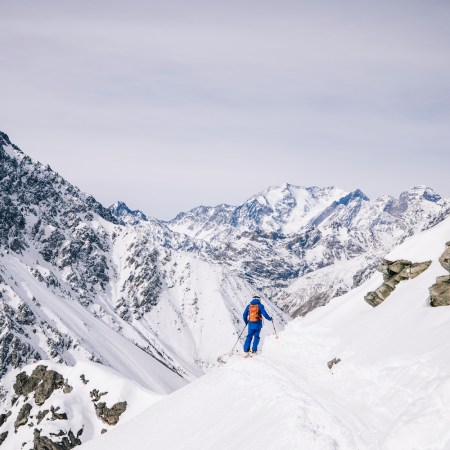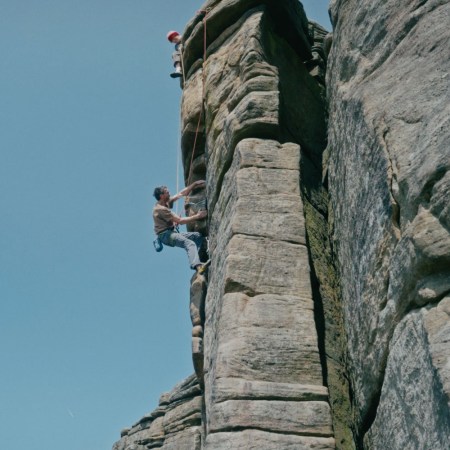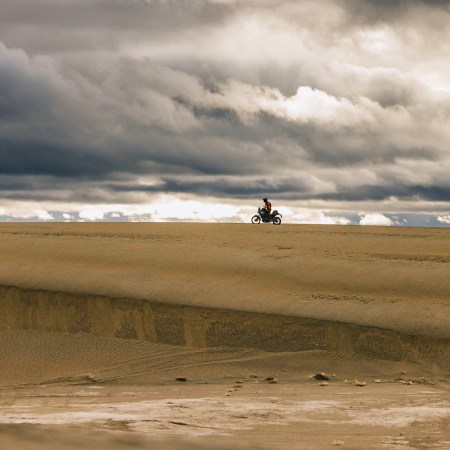We’ll get ahead of this nice and early: InsideHook is not liable for those who choose to attempt (and will almost certainly fail — in spectacular, limb-endangering fashion) to complete our list of the best endurance events of the year.
In a different time, this sort of calendar might’ve functioned as a tongue-in-cheek hypothetical. Or perhaps just a bucket-list repository of events that endurance athletes could sign up for, at some point in their careers. But these days, we’ve got people running seven marathons in seven days, on seven different continents. The adventurer arms race has completely spiraled out of control.
However you choose to process this calendar — aspirational or a legitimate call to arms — just know that it is chock-full of crazy challenges that 99.9% of the planet can’t do and probably shouldn’t want to do. Keeping your heart rate nice and low during any ultramarathon is hard enough, but how about doing so while pitching camp, deep in a damp jungle, with another 50 miles to run tomorrow?
Below, 12 endurance races, one for each month of the year, with a focus that goes well beyond the world of running. We’ve got stints of cycling, climbing, rowing and even sled-pulling, if that’s your thing, in locations all around the globe. Pick your poison, or pick all of them, and start downloading David Goggins podcasts to your phone. There isn’t much service where you’re headed.
January: Arrowhead 135
Where: International Falls, Minnesota
Why: There are plenty of summery Southern Hemisphere races at this point in the year, but where’s the fun in that? The Arrowhead 135 is held each year in International Falls, Minnesota, one of America’s coldest towns. Checks out. Racer’s choice: you can cover those 135 miles by bike, on foot or even on skis. But you have to carry your own food, water and survival gear. Like most races on this list, there’s a time window — the race must be completed within 60 hours. (The all-time record is just under 12 hours by bike.) The Arrowhead 135 is essentially a perennial power vortex. Temps are guaranteed to hit -30 degrees. In an average year, 50% of racers fail to finish.
February: Yukon Arctic Ultra
Where: Whitehorse, Canada
Why: Another inconceivably cold ultra, deep in the northerly Canadian wilderness. Similar to Arrowhead 135, athletes have the option to run, bike or ski the Yukon Arctic Ultra. They also have a dastardly suite of distance preferences at their disposal: marathon, 100-mile, 300-mile and the grueling 430-mile. Each competitor must pull a sled carrying their survival gear, food and water, with only occasional checkpoints for aid. Each race begins at Whitehorse, which isn’t just frozen at this time of year…it’s dark. February days here last just nine hours. Still, a bonus of sorts: Whitehorse has the Guinness World Record distinction of “the city with the least air pollution” in the world.
March: The Barkley Marathons
Where: Frozen Head State Park, Tennessee
Why: For some context, it was a big deal last year when five people completed the Barkley Marathons. Only 20 have managed to make it to the finish line since race operator/jolly masochist Lazarus Lake invented the race back in 1986. The Barkley was created after Lake (whose real name is Gary Cantrell) read about the escape attempt of James Earl Ray, Martin Luther King Jr.’s assassin, who broke out of the Brushy Mountain State Penitentiary in 1977. Ray lasted only eight miles in the Tennessee wilderness before he was recaptured; Cantrell reckoned he would’ve been able to travel at least 100 miles, terrain, elevation change and weather conditions notwithstanding. Today’s race involves five 20-or-so-mile loops, a 60-hour time limit and 63,000 feet of elevation gain on unmarked trails. But no matter how much of a badass you may be, there’s no guarantee you’ll ever get to race it: Cantrell populates the race through ultra-secret means. “Virgins” must write an essay explaining why they should be allowed to run the race; if accepted, they receive a “letter of condolence.”
April: Patagonia Run
Where: San Martín de los Andes, Argentina
Why: The magnificence of the Andes draws people from all over the world, and as the Patagonia Run takes place in April, you’ll get to experience the many mood swings of the storied mountain range: sun, rain, sleet, even snow. The event runs like a well-oiled machine, having been around for 15 years, but you’re required to carry an emergency blanket (among other safety gear) on the 100-miler in case your body doesn’t. With three summits included in the route, organizers caution that this race isn’t only a “technical challenge, but one against exhaustion, weather and the ultra-distance.” Last year’s winner finished in 20 hours and 25 minutes, but they’ll let you take about double that to get across the line. You’ll need it.
May: Unbound Gravel
Where: Emporia, Kansas
Why: God, we wish they had kept the original name. The Dirty Kanza is now Unbound Gravel, which sounds (a little) less like a “big move” in the bedroom. Unbound is the world’s premier gravel grinder bike race — which means it incorporates elements of asphalt, gravel and dirt (though mostly the latter two) — and tackles 350 miles of the most remote and unforgiving gravel roads throughout Cowley County. Weather usually plays a devilish role, even this early in the year: either the temperature’s pushing past 100 degrees, or the rain’s turning the paths to mud. Riders spend long hours in the saddle with minimal support, with no official checkpoints; instead, towns on the route are noted for supply refills. Nonetheless, the event has surged from 34 riders in its first year (2006), to now around 5,000 across all races, though only about 200 for the full 350-mile route.
June: Jungle Ultra
Where: Manu National Park, Peru
Why: There’s one environment that might be a worse stage than the desert for an endurance event. Peru’s Jungle Ultra takes runners through 143 miles of the Amazon Rainforest. It’s humid, it’s hot, it’s hilly. Runners have to carry hammocks, food and survival gear up 9,000 feet of elevation, in temperatures that regularly careen past 90 degrees. How’d you like to be at your stickiest, racing under a canopy so thick that you begin to forget what the sky looks like? This race takes place in Manu National Park, one of the most biodiverse areas on the planet, which is probably best enjoyed from a couch while watching Planet Earth.
July: Badwater 135
Where: Death Valley, CA
Why: You know the one. The fact that this mind-melter of a race takes place in July feels a little gratuitous, but that’s the point. Badwater starts in Death Valley (282 feet below sea level) and ends at Whitney Portal (8,300 feet). It covers 135 miles through three mountain ranges. Temperatures can climb to 130 degrees. Even the fastest runners need a full 24 hours to finish the race, and like the Barkley Marathons, there are way more people trying to get into this race than those allowed to run it each year. Note to those who do gain entry: auxiliary intravenous fluid will result in automatic ejection.
August: Norseman Xtreme Triathlon
Where: Eidfjord, Norway
Why: It’s August in Norway, and the water is so cold that PhD’d adults are still conducting a multi-year “Cold Water Research Project” to make sure athletes have a fighting chance. The fabled Norseman Xtreme Triathlon has no support crews, no cheering crowds, no predictable weather. The race starts with a leap into a fjord, followed by a full Ironman: the full swim, a cycle through the mountains and a marathon with a finish atop Mount Gaustatoppen. This might be the most beautiful race on offer here. From your perch on Gaustatoppen, they say you’ll be able to see one-sixth of Norway. Feel free to hallucinate the rest.
September: Tor des Géants
Where: Aosta Valley, Italy
Why: Courmayeur is an award-winning ski hamlet in the Italian Alps. Tor des Géants begins and ends here. At 205 miles, it’s one of the longest ultramarathon trail races in the world. Runners — we might as well call them hikers — have to digest 78,700 feet of elevation gain and 25 mountain passes within a 150-hour time limit. Grueling, to be sure, and there are far gentler ways to pass through Alpine towns, but considering this calendar includes stints near the Arctic Circle, you could do worse than gliding through Italy’s “High Regions” over the span of a week. Here’s what it looks like.
October: Moab 240
Where: Moab, Utah
Why: It’s the ultra that beat David Goggins. There’s a good chance the Moab 240 will beat you, too: with 200 spots available, in 2023 just 112 entrants completed the entire course. And about that route…it’s 240 miles surrounded by two national parks (Canyonland and Arches) and peppered with rocky canyons and desolate desert stretches, with a total elevation gain and loss of 31,564 feet. Last year, the first-place finisher took almost three days to traverse the red rock wonderland (wasteland?), so yes, your body will force you to grab some shut-eye along the way.
November: Antarctic Ice Ultra
Where: Ultima Base Camp, Antarctica
Why: For many of these races, the diversity of the course itself is the draw: winding paths through unknown territory, sometimes testing navigation skills as much as physical endurance. For the Antarctic Ice Ultra, first held in 2024, the course is a 2.6-mile loop, which means the mental test is completely flipped: can you handle the mundanity of slogging through 100 miles around a groomed snow track at the actual end of the world? Can your body keep moving when the average windchill is -4 degrees and base temperatures get as low as -13? A handful of people did actually finish, so I guess it is physically (and mentally) possible.
December: World’s Toughest Row
Where: La Gomera, Canary Islands to Antigua
Why: The name says it all. The World’s Toughest Row takes challengers (madmen) on a 3,000-mile journey across the Atlantic. Most of the events on this calendar take a week at most, but this crucible of ocean rowing generally stretches anywhere from 40 to 90 days. The row starts at San Sebastián de La Gomera in the Canary Islands and finishes in Nelson’s Dockyard on Antigua. It’s December, so expect storms. Oh, and giant waves, sleep deprivation, salt sores and blisters. On the bright side, you’ll have a front-row seat to some spectacular sunsets and star-filled nights. There’s no traditional support, no pit stops, no toilets. All your food for the journey must be carried on board from the start, while your boat’s desalinator will provide the freshwater needed to survive. The record time to cross is 29 days, 13 hours, and 34 minutes.
The Charge will help you move better, think clearer and stay in the game longer. Subscribe to our wellness newsletter today.


























